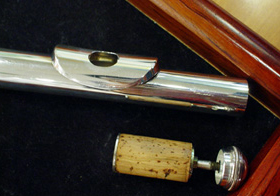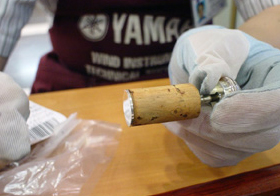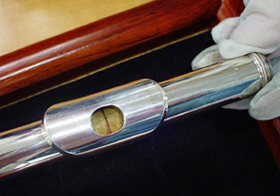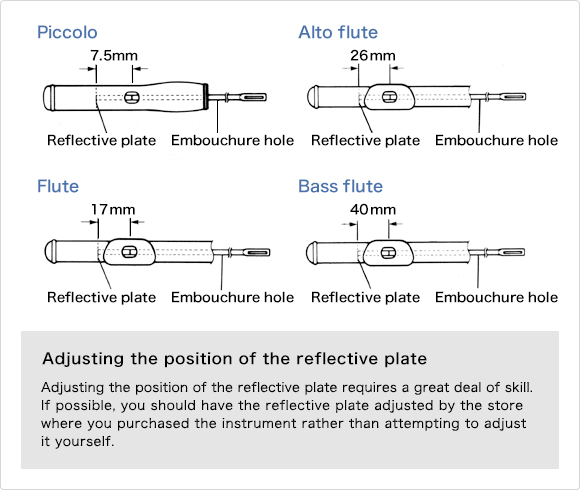Care and Maintenance of a Flute
Check the reflective plate!
Has the reflective plate been accidentally pushed too far into the tube!
Inside the flute there is a metal plate (known as the "reflective plate"), close to the embouchure hole. The pitch of a wind instrument is determined by the length of the tube. When a flute is played, however, the length of the tube is effectively the distance from the hole that is covered by a finger to the position of this reflective plate. The reflective plate thus has a crucial influence on the pitch of the instrument.

The reflective plate and the head screw, after removal from the head joint.
Cork is sandwiched between the head screw (at left) and the reflective plate (at right).

The reflective plate and the cap are connected by a screw
However, this reflective plate may slip out of place for some reason-for example, if it is pushed when the head screw has worked loose and is being tightened, or if it is pushed with a cleaning rod during maintenance. (The head screw is at the upper end of the flute's head joint.) If the reflective plate slips out of position, the pitch balance is destroyed, and the instrument cannot produce the correct pitch. In other words, if it suddenly becomes hard to hit the right notes, it may be that the reflective plate has slipped out of position.
To quickly determine whether the reflective plate is in the correct position, check whether the line on the cleaning rod that came with your flute lines up with the center of the embouchure hole when you insert the rod into the head joint. Incidentally, the correct distance from the center of the embouchure hole to the reflective plate is 17 mm. (The standard values for the piccolo, alto flute, and bass flute are 7.5 mm, 26 mm, and 40 mm, respectively.)

Check the position of the reflective plate using the line on the rod
Insert the cleaning rod and check the position of the reflective plate using the line on the rod. If the line is dead center in the embouchure hole, the reflective plate is in the correct position.

If you check the cleaning rod and find that the line is too far toward the main tube (that is, toward the keys), loosen the head screw, wrap the tip of the cleaning rod in gauze, and push the reflective plate back into its correct position. If, instead, the line is too far toward the head screw, first loosen the head cap, push the reflective plate back into its correct position, and retighten the head cap. If the cork is worn down, replace it with a new one. It is probably best to have this done at your local specialized music shop. Make a habit of checking the cork from time to time, as it affects the quality of the sound and can wear down fairly easily.
